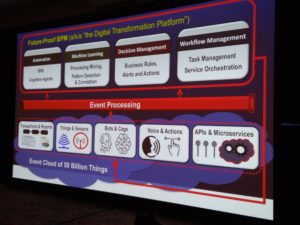Nathaniel Palmer kicked off day 2 of bpmNEXT 2018 with his ever-prescient views on the next five years of BPM. Bots, decisions and automation are key, with the three R’s (robots, rules and relationships) defining BPM in the years to come. More and more, commercial transactions (or services that form part of those transactions) will happen on servers outside your organization, and often outside of your control; robots and intelligent agents will be doing a big part of that work. He also believes that we’re seeing the beginning of the death of smartphones, to be replaced with other devices and other interfaces such as conversational UI and wearable technology. This is going to radically change how apps have to be designed, and will leave a lot of companies scrambling to catch up with this change as people move more of their interactions off smartphones and laptops. Although more conservative organizations — including government agencies — will continue to support the least common denominator in interaction style (probably email and traditional websites), commercial organizations don’t have that luxury, and need to rethink sooner. He envisions that your fastest-growing competitors will have fewer employees than robots, although some interesting news out of Tesla this week may indicate that it’s premature to replace some human functions.
He spoke about how this will refine application architecture to four tiers: a client tier unique to each platform, a separate delivery tier that optimizes delivery for the platforms, an aggregation tier that integrates services and data, and a services tier that pulls data from both internal and external source. This creates an abstraction between what a task is and how it is performed, and even whether it is automated or performed by a person. Decision as a service for both commercial and government services will become a primary delivery model, allowing decisions (and the automation enabled by them) to be easily plugged into applications; this will require more of a business-first, model-driven approach rather than having decisions built in code by developers.
 His Future-Proof BPM architecture — what others are calling a digital transformation platform — brings together a variety of capabilities that can be provided by many vendors or other organizations, and fed by events. In fact, the core capabilities (automation, machine learning, decision management, workflow management) also generate events that feed back into the data flooding into these processes. BPM platforms have the ability to become the orchestrating platforms for this, which is possibly why many of the BPMS vendors are rebranding as low-code application development environments, but be aware of fundamental differences in the underlying architecture: do they support modularity and microservices, or are they just lifting and shifting to monolithic containers in the cloud?
His Future-Proof BPM architecture — what others are calling a digital transformation platform — brings together a variety of capabilities that can be provided by many vendors or other organizations, and fed by events. In fact, the core capabilities (automation, machine learning, decision management, workflow management) also generate events that feed back into the data flooding into these processes. BPM platforms have the ability to become the orchestrating platforms for this, which is possibly why many of the BPMS vendors are rebranding as low-code application development environments, but be aware of fundamental differences in the underlying architecture: do they support modularity and microservices, or are they just lifting and shifting to monolithic containers in the cloud?
Finishing up, he returned to the concept that intelligent agents can act autonomously in complex transactions, and this will be becoming more common over the next few years. Interestingly, an interview that I did for a European publication is being translated into German, and the translator emailed me this morning to tell me that they needed to change some of my comments on automating loan transactions since that’s not permitted in Germany. My response: not yet, but it will be. We all need to be prepared for a more automated future.
Great audience discussion at the end on how this architecture is manifesting, how to model/represent some of these automation concepts, the role of a smarter event bus, the future of the word “bot” and more. Max Young from Capital BPM took over to discuss the development of a grammar for RPA, with an invitation for the brain trust in the room to start thinking about this in more detail. RPA vendors are creating their own notation, but a vendor-agnostic standard would go a long ways towards helping business people to directly specify automation.
Since they’re pumping out the video on the same day as the presentations, check the bpmNEXT YouTube channel later for a replay of Nathaniel’s presentation.
